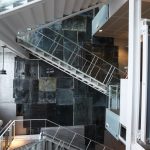

Nicolas Baier, who lives and works in Montréal, holds a bachelor’s degree in visual arts from Concordia University. In 2003, he had a solo exhibition titled Scènes de genre at the Musée d’art contemporain de Montréal. On the occasion of the fiftieth anniversary of Place Ville Marie, in 2012, he produced Autoportrait. The work, reproducing a meeting room in nickel, was installed under a glass cube on the esplanade of the tower designed by Ieoh Ming Pie. Baier’s works are in numerous private and public collections, including the Musée d’art contemporain de Montréal, the Musée des beaux-arts du Québec, and the Canadian Museum of Contemporary Photography.

- 14 Artworks
- 45min
- Champ-de-Mars metro station
 Centre d'histoire de Montréal
Centre d'histoire de Montréal 
Artwork description
Vanités 3, Les miroirs du temps was expressly designed for Pointe-à-Callière’s fifth pavilion under the policy to integrate art into the museum’s architecture and environment. The work is an immense photographic composition of 75 digital images of mirrors that covers practically the entire west wall of the pavilion hall. It constitutes a reference to the museum’s mission as a space for memory and a witness to the passage of time. Moreover, the mirrors used by the artist were found in Québec and Europe, in antique stores, shops, homes and waste bins: a patient exercise that brings to mind the research efforts by historians and archaeologists. The narrative of the work produced by the technique and the methodological composition of the compartments suggest the archaeological site grid.



